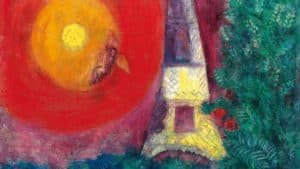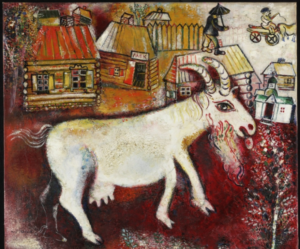The sale puts an entirely new spin on the notion of ‘art appreciation’

When the National Gallery of Canada auctions off one of its two Marc Chagall paintings next month, it will not only raise the money to buy what gallery director Marc Mayer says is a more significant work of art, it will make millions of dollars in profit.
Mayer tells CBC that the gallery’s La Tour Eiffel was bought back in 1956 for just $16,000 — roughly $146,000 in today’s dollars. The expectation is that when the painting is auctioned next month by Christie’s, it will fetch anywhere from US $6 million to $9 million (that’s $8 to $11 million Canadian). Some believe the painting could fetch even more.
It’s the kind of return that gives new meaning to the term ‘art appreciation’.
We need some money fast. And this is the last stop. We have tried everything else.
– National Gallery of Canada Director Marc Mayer
“We were trying to match stickers in this case because we didn’t want to risk not raising enough money with smaller, less significant things,” Mayer said in an interview airing on CBC Radio’s The House.
“We thought (of) one thing that we can live without, that would not be a national tragedy, and I don’t think selling this particular painting by Chagall is a national tragedy … All of the people who had the responsibility to weigh in on this … the eight people with PhDs in art history who are part of the process of deciding this, agree.”

Mayer acknowledged that not everyone agrees. When CBC News broke the story of the sale this week, the outgoing head of the Canadian branch of the International Association of Art Critics called the sale an act of “monumental stupidity” and said it should be stopped.
“Future generations will not forgive the gallery for that loss,” Ninon Gauthier said.
Mayer said La Tour Eiffel spends most of its time in storage because the gallery considers the other Chagall in its collection — Memories of Childhood — to be a better example of his work and historically more significant.

“We are trading up for something that we think is significantly more important in art history and would never leave the walls,” he said. “It would not be a secondary work to one that is more important. It would be unique in our collection.”
Mayer would love to say more about the mystery painting the gallery is working to acquire because, he said, “it’s a wonderful story.”
But he said he just can’t. Can’t say who the seller is, can’t say what it is about the painting that means it just has to be part of the gallery’s collection — or whether the artist is even Canadian.
What he does say is that the gallery has the right of first refusal.
“There’s a painting that’s about to leave Canada. We have it on good authority that it’s gonna leave Canada and it has been offered to us, and it’s been offered to some foreign museums who would buy it in a heartbeat. And we don’t think it should leave Canada.”
It’s the first time, to his knowledge, that the National Gallery has had to sacrifice one artwork in order to buy another. Normally, private donors can be counted on to chip in, or to buy a significant piece outright to give to the gallery.
That didn’t happen in this case.
“We need some money fast,” Mayer said. “And this is the last stop. We have tried everything else.”
Mayer said he can’t just spend the gallery’s entire $8 million annual acquisitions budget on one work of art because he has six other collections to curate.
He also said it would be inappropriate for him to ask the government to increase that budget — even though the amount hasn’t changed for 17 years — or to kick in money for what he sees as a once-in-a-lifetime opportunity for the National Gallery.
Mayer did tell the government about his plans.
“They understand the process by which works are acquired,” he said. “And they wished us good luck.”
Mayer said he doesn’t think he’ll need it when the Chagall goes up for auction next month.


